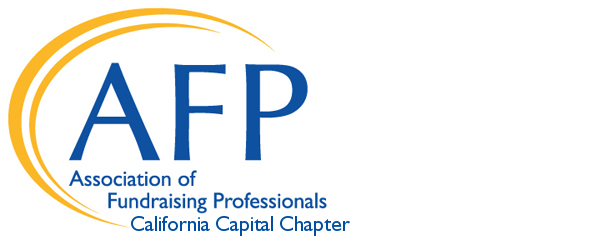Fundamentals of Fundraising
Summary:
The Association of Fundraising Professionals – California Capital Chapter is pleased to offer the AFP Fundamentals of Fundraising Course. This intensive 2-day course offers a complete overview of the development function, featuring the most current information and techniques designed by experienced professionals to meet the real world needs and challenges nonprofit organizations face every day.
Benefits:
Program participants will walk away with:
• Strong understanding of how to build a comprehensive fundraising program
• Concrete tools and strategies in a variety of fundraising techniques
• Expert instruction taught by local fundraising professionals
• A cohort of peers for networking and support
Bonuses:
• Applicable for 16 hours credit towards CFRE International certification
• Workbooks and course materials valued at $190
Course Hours:
TBA
Program Overview:
The Fundamentals of Fundraising course consists of 7 modules taught by experienced fundraising professionals. The course is taught in an active-learning style and includes case studies and projects for groups and individuals, making the learning experience both substantive and enjoyable.
Modules include: Overview of Fundraising, Developing an Integrated Fundraising Program, Marketing for Ongoing Success, Building and Sustaining Relationships, Securing the Gift, Volunteers - Partners in Fundraising, and Management & Accountability.
This intensive 16-hour program will provide an overview of skills, techniques, and program components for individuals with 1 to 5 years of fundraising experience.
Course Objectives:
Upon completing each module, participants should be able to:
Overview of Fundraising:
o Explain the culture of philanthropy and the role philanthropy plays in organizations
o Name 8-10 key reasons people give
o Describe the primary sources of contributions
o Describe the essential components of an integrated development program and the primary purpose of each one
o State key qualities that every fundraiser should possess and describe a basic path for personal professional development
o Describe the key principles of the Donor Bill of Rights and the AFP Code of Ethics
Developing an Integrated Fundraising Program
o Discuss the relationship between the organization's overall mission and strategic plan and the development plan
o State the reasons for coordinating the budgeting and planning process of the fundraising department with that of the overall organization
o Define elements in background information and in the case for support that will have the most appeal to appropriate stakeholders, both emotionally and rationally
o Describe the essential components of an integrated development program
o Identify stakeholders typically affected by a development plan
o Distinguish the differences between and uses for annual giving, major gifts, and planned giving
o Describe the key characteristics of individual and group solicitations, and when each is most effectively used
o Define the reasons for and differences between gift acknowledgment, acceptance, and recognition policies
Marketing for Ongoing Success
o Explain the definition of marketing and describe its application to fundraising.
o Cite examples of communications methods and describe how each might be used to cultivate and retain donors
o Identify a variety of ways an organization's marketing message can be shared with stakeholders, and suggest which best fit particular stakeholders
o Prepare donor-centered solicitation materials that will influence and facilitate informed gift decisions
o Describe the roles of the Internet and social media in fundraising
Building & Sustaining Relationships
o Explain the role of research in identifying individuals and groups with the capacity and potential to give in order to qualify them for further research and cultivation efforts
o Describe examples of effective cultivation strategies and identify steps to use to maximize gift return on an ongoing basis
o Identify the basic elements of good relationships with volunteers, donors, and qualified prospects
o Cite examples of effective relationship-building strategies
o Define "stewardship" and describe its role in building lasting relationships
o Discuss application of appropriate acknowledgment, acceptance, and recognition policies and practices
Securing the Gift
o Describe solicitation techniques used in annual giving programs
o Identify, recruit, and prepare the appropriate mix of volunteers, staff, and professionals to carry out solicitations
o Name the additional training needs for volunteers involved in solicitation.
o Discuss the six steps to a "model" major-gift solicitation
o List strategies for obtaining support from corporations/businesses, foundations, and government entities
o Describe the process for developing and presenting a written grant proposal.
o Discuss application of appropriate acknowledgment, acceptance, and recognition policies and practices
Volunteers - Partners in Fundraising
o Explain ways to use volunteers to help achieve organizational and fundraising objectives
o Discuss the key elements of a structured process for identifying, recruiting, managing, motivating, evaluating, and retaining volunteers
o Describe a model volunteer orientation program
o Explain the board's role in fundraising
o Describe methods for recognizing volunteers
Management & Accountability
o Participate appropriately in the organization's budget and planning process
o Describe key considerations in receiving, accepting, recording, acknowledging, tracking, and reporting gifts and pledges
o List the primary roles and responsibilities of the board, CEO, and development officer
o Discuss methods for evaluating development program performance
o Identify basic accounting and tax requirements that apply to gifts and pledges
o Discuss the relevant legal, regulatory, and ethical requirements for information maintained in a donor database, and state potential sources for this information

